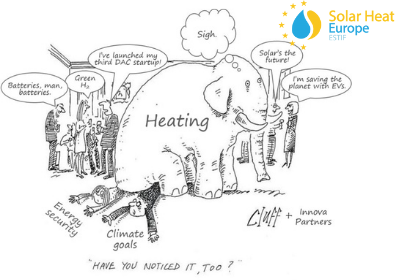28 January: International Day of Action against Global Warming
28 January is the International Day of Action against Global Warming, better known as International CO2 Emissions Reduction Day. This date was chosen by the United Nations to raise awareness of the problem of global warming and its consequences on the planet, and to encourage people to take action and decisions to combat it. The current situation, at the beginning of 2022, shows no signs of slowing down and in 2021 the IPCC published its alarming report on the situation and its predictions are more than pessimistic for our future.
However, you are probably wondering what global warming is and what it consists of. We take a look at the science to explain all aspects of this phenomenon that already permeates our daily lives at all levels.
What does Global Warming mean?
Global warming is the increase in the Earth’s temperature caused mainly by greenhouse gas emissions from human activity. Here is a quick and simple definition of global warming.
But let’s take our definition one step further: the greenhouse effect is the warming that occurs when certain types of gases in the atmosphere retain heat. Sunlight shines onto the earth’s surface, where it is absorbed and then returned to the atmosphere as heat. In the atmosphere, greenhouse gases retain some of this heat and the rest escapes into space. The more greenhouse gases there are, the more heat is retained. To give you an idea, this is the same principle as the windows of a greenhouse.
Greenhouse gases were discovered in 1824, when the scientist Joseph Fourier calculated that the Earth would be much colder if we had no atmosphere. Thus, this famous greenhouse effect is essential for us, as it allows the Earth’s climate to be habitable. Without it, many scientists estimate that the Earth would be 15 degrees Celsius colder. Then, in 1895, the Swiss chemist Svante Arrhenius made the discovery of greenhouse gas when he realised that human activity could increase the greenhouse effect due to its large production of carbon dioxide.
Many climate sceptics argue that the Earth has always experienced periods of warming and cooling and that there is nothing new about this. However, while the start of their argument is a good one, they forget one essential and important fact:
Temperatures have never risen so rapidly and sharply.
Global average temperature and concentrations of carbon dioxide (one of the main greenhouse gases) have fluctuated over a cycle of hundreds of thousands of years as the Earth’s position relative to the sun has varied. As a result, the different ice ages have occurred. However, over thousands of years, GHG emissions to the atmosphere have been offset by naturally absorbed GHGs. Therefore, GHG concentrations and temperature have been fairly stable. This stability has allowed human civilisation to develop in a consistent climate. Occasionally, other factors have a brief influence on global temperature. Volcanic eruptions, for example, emit particles that temporarily cool the Earth’s surface. However, these do not have an effect that lasts more than a few years. Other cycles, such as El Niño, also occur briefly and in predictable cycles. Humans have now increased the amount of carbon dioxide in the atmosphere by more than a third since the industrial revolution. Such significant changes have historically occurred over thousands of years but are now occurring in just a few decades.
What are its consequences on the planet?
These abrupt and rapid changes in our climate have profound and worrying consequences for our planet. In fact, global warming imposes such a sudden change in climate that some living species cannot adapt to it.
We mentioned earlier that the Earth’s climate has always varied and oscillated between temperatures like today’s and much colder ones. So cold, in fact, that ice sheets once covered much of the North American and European continents. However, we stress that these temperature changes have always occurred slowly, over thousands of years, and that the difference between global average temperatures and those of the ice ages was only 12 degrees Celsius.
In fact, for the first time since records have been kept, the findings of a recent study published last March have challenged climate evolution estimates by revealing that the capacity of the world’s largest rainforest to absorb carbon from the atmosphere has been reduced to such an extent that it may already be releasing more carbon than it stores.
The impact of global warming is affecting all regions of the world without exception. The two main impacts of this change are the alteration of biodiversity with the depletion of natural resources, and the alteration of the oceans and seas. Let us look at these in more detail.
The melting of the ice sheet has many negative consequences for our planet. Indeed, the melting of the ice sheet causes a rise in average sea and ocean levels. The IPCC predicts an average rise of 82 cm by 2100 if we do not take action to limit global warming and reduce our greenhouse gas emissions.
This sea level rise would have a major impact on coastal areas around the world. The comprehensive expert report The Ocean and Cryosphere in a Changing Climate (2019) sets out the consequences of global warming on the oceans and cryosphere and its impacts on human societies and ecosystems. The ocean is a carbon sink, meaning that it absorbs carbon dioxide (CO2) from the atmosphere and stores it. However, the accumulation of CO2 in the ocean changes its composition and causes acidification that directly threatens its absorption capacity.
However, this rise in water levels leads to a loss of territory and land, which has a direct impact on agriculture and fisheries, affecting food security. In addition, climate change is also leading to more frequent and intense extreme weather events, such as floods, forest fires, heat waves, etc. This is pushing people to migrate in order to survive. This causes people to migrate in order to survive. Fauna and flora are also sensitive to these changes and some species are forced to migrate or adapt as quickly as possible to avoid extinction.
Are there solutions to combate it?
Unfortunately, many scientists agree that many of the effects of global warming are irreversible. Moreover, the latest IPCC report, published in August 2021, made an alarming observation about global warming. In its more than alarming and catastrophic report, the IPCC calls on politicians and citizens to take real action to limit the climate catastrophe.
There is still time to act, but it must be done quickly. Ideally, we would like to limit global warming to +1.5°C, but this requires an immediate reduction of our global greenhouse gas emissions. To achieve this, here are some solutions:
One of the key points to reduce the carbon footprint is to optimise energy consumption. This is possible by opting for renewable energies. Here it is important to think that the answer should not only be electrical, but also thermal. Hybrid solar technology offers a complete answer. Our aHTech technology, adapted to all sectors with a high demand for hot water and electricity, has already enabled more than a hundred industries to reduce their environmental impact. The Iberostar group has chosen our technology for three of its hotels, enabling it to reduce its CO2 emissions by an average of 200,000 kg.
Share this article on your social networks
Subscribe our Newsletter!
External news
Featured Post
Recent Posts
Related Posts…
Write us, we will answer you as soon as possible.
Responsible for the data: Abora energy S.L.
Purpose: Sending emails with news and offers.
Legitimation: Your expressed consent.
Recipient: Subscribers’ list in Mailchimp.
Rights: Access, rectification, elimination, anonymity, portability and forgetting data.












